child seat TOYOTA GT86 2013 Owners Manual (in English)
[x] Cancel search | Manufacturer: TOYOTA, Model Year: 2013, Model line: GT86, Model: TOYOTA GT86 2013Pages: 448, PDF Size: 13.47 MB
Page 2 of 448
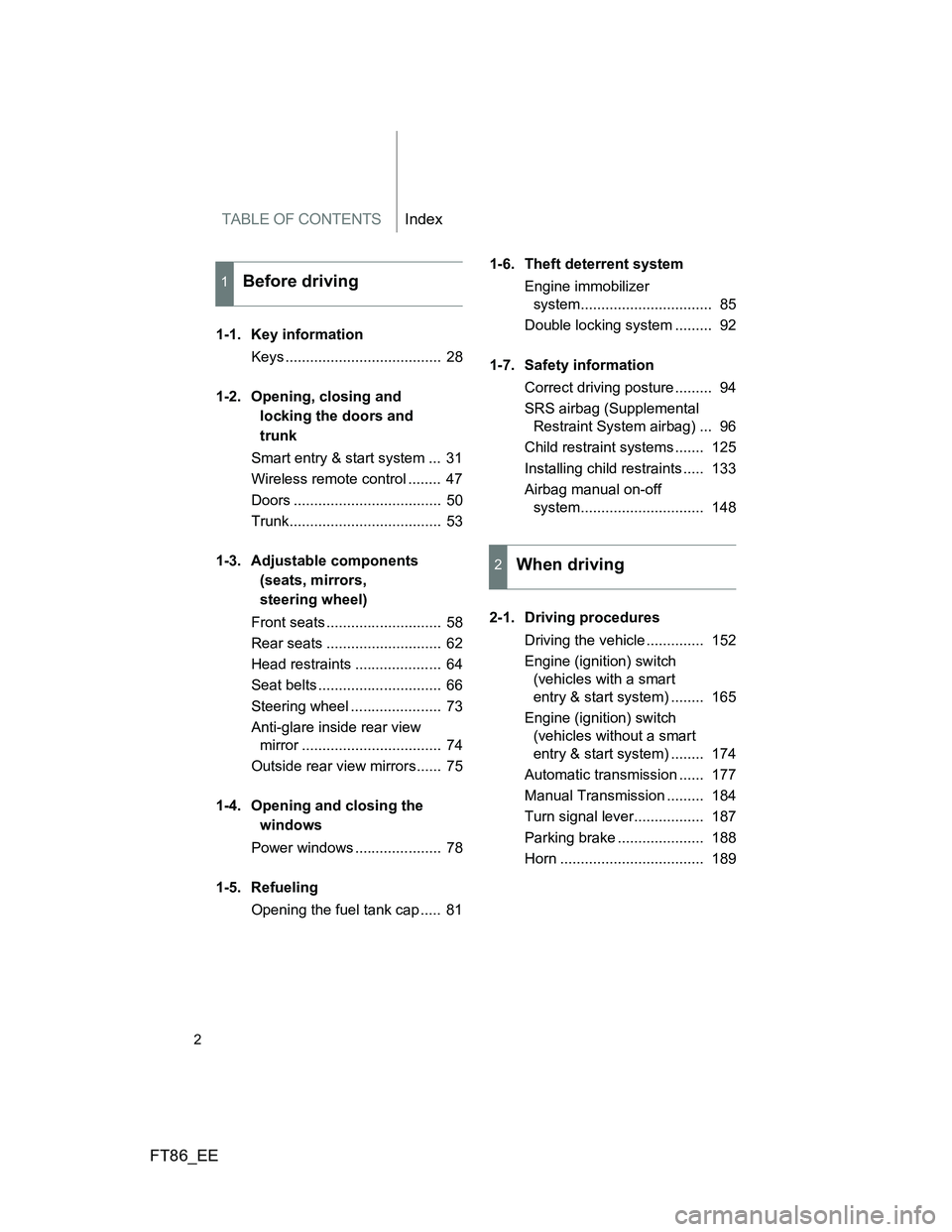
TABLE OF CONTENTSIndex
FT86_EE
2
1-1. Key information
Keys ...................................... 28
1-2. Opening, closing and
locking the doors and
trunk
Smart entry & start system ... 31
Wireless remote control ........ 47
Doors .................................... 50
Trunk..................................... 53
1-3. Adjustable components
(seats, mirrors,
steering wheel)
Front seats ............................ 58
Rear seats ............................ 62
Head restraints ..................... 64
Seat belts .............................. 66
Steering wheel ...................... 73
Anti-glare inside rear view
mirror .................................. 74
Outside rear view mirrors...... 75
1-4. Opening and closing the
windows
Power windows ..................... 78
1-5. Refueling
Opening the fuel tank cap ..... 811-6. Theft deterrent system
Engine immobilizer
system................................ 85
Double locking system ......... 92
1-7. Safety information
Correct driving posture ......... 94
SRS airbag (Supplemental
Restraint System airbag) ... 96
Child restraint systems ....... 125
Installing child restraints ..... 133
Airbag manual on-off
system.............................. 148
2-1. Driving procedures
Driving the vehicle .............. 152
Engine (ignition) switch
(vehicles with a smart
entry & start system) ........ 165
Engine (ignition) switch
(vehicles without a smart
entry & start system) ........ 174
Automatic transmission ...... 177
Manual Transmission ......... 184
Turn signal lever................. 187
Parking brake ..................... 188
Horn ................................... 189
1Before driving
2When driving
Page 8 of 448
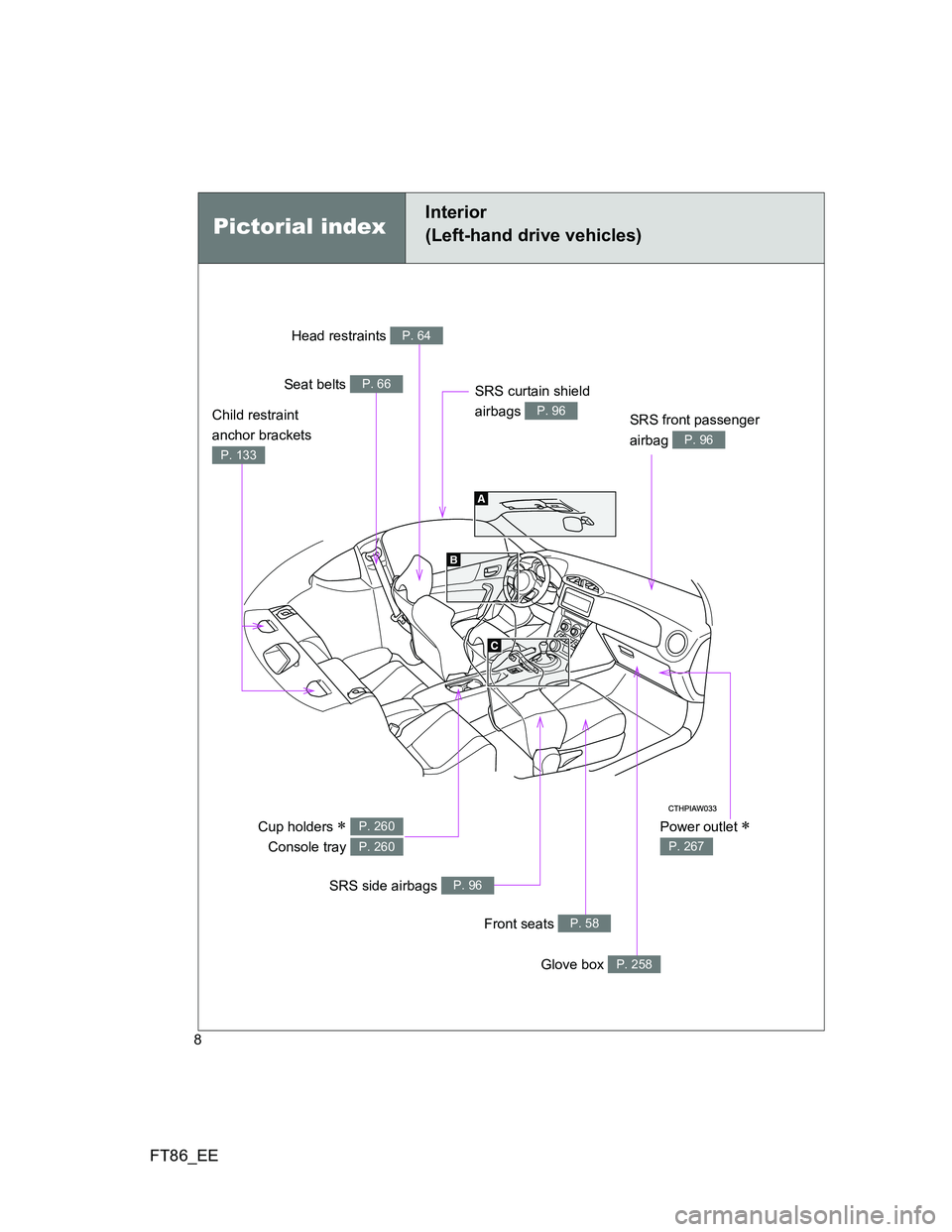
FT86_EE
8
Pictorial index
Interior
(Left-hand drive vehicles)
Power outlet
P. 267
Head restraints P. 64
Seat belts P. 66
SRS front passenger
airbag
P. 96
Cup holders
Console tray P. 260
P. 260
SRS side airbags P. 96
Front seats P. 58
Glove box P. 258
SRS curtain shield
airbags
P. 96Child restraint
anchor brackets
P. 133
Page 14 of 448
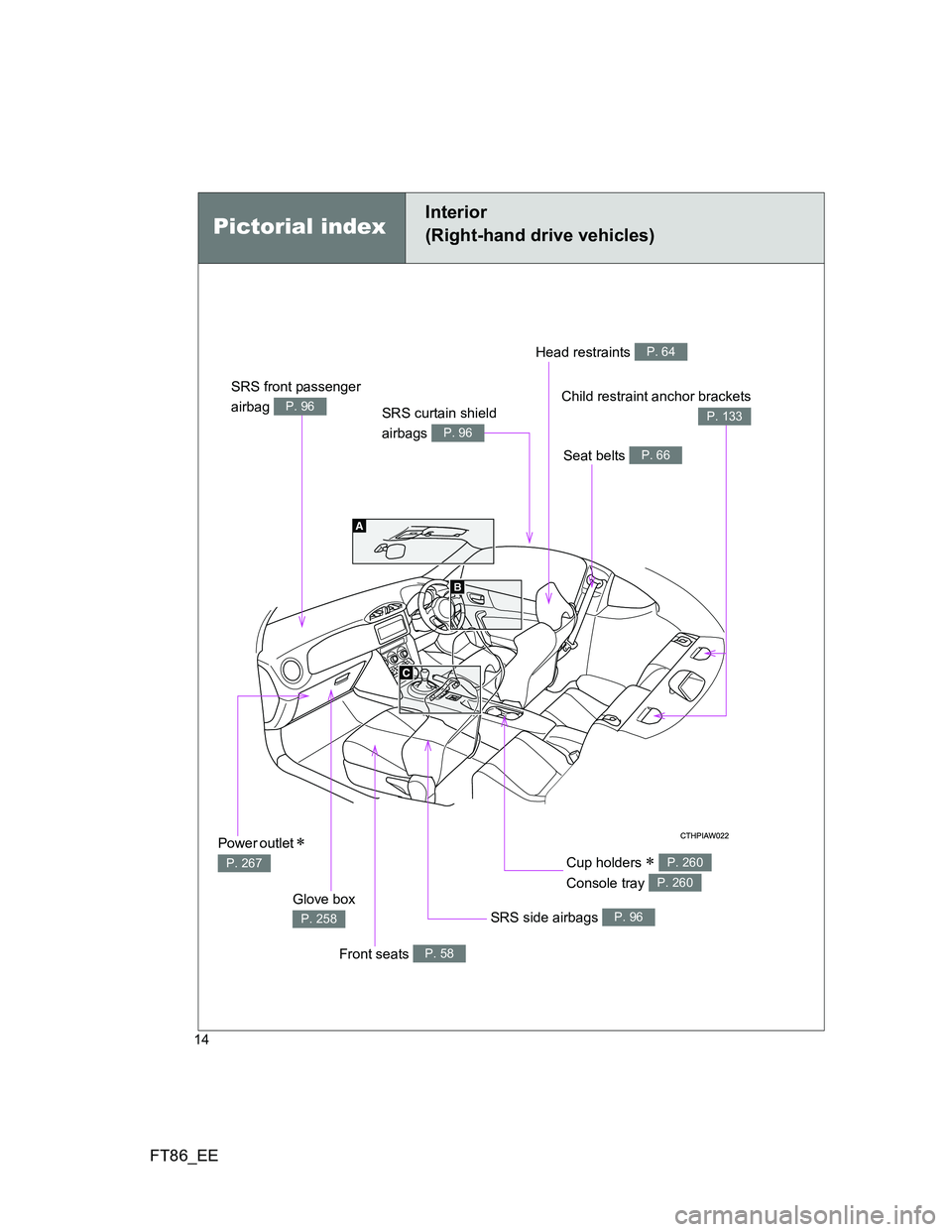
FT86_EE
14
Pictorial index
Interior
(Right-hand drive vehicles)
SRS front passenger
airbag
P. 96
Head restraints P. 64
Seat belts P. 66
Child restraint anchor brackets
P. 133
Power outlet
P. 267
Glove box
P. 258
Front seats P. 58
SRS side airbags P. 96
Cup holders
Console tray P. 260
P. 260
SRS curtain shield
airbags
P. 96
Page 23 of 448
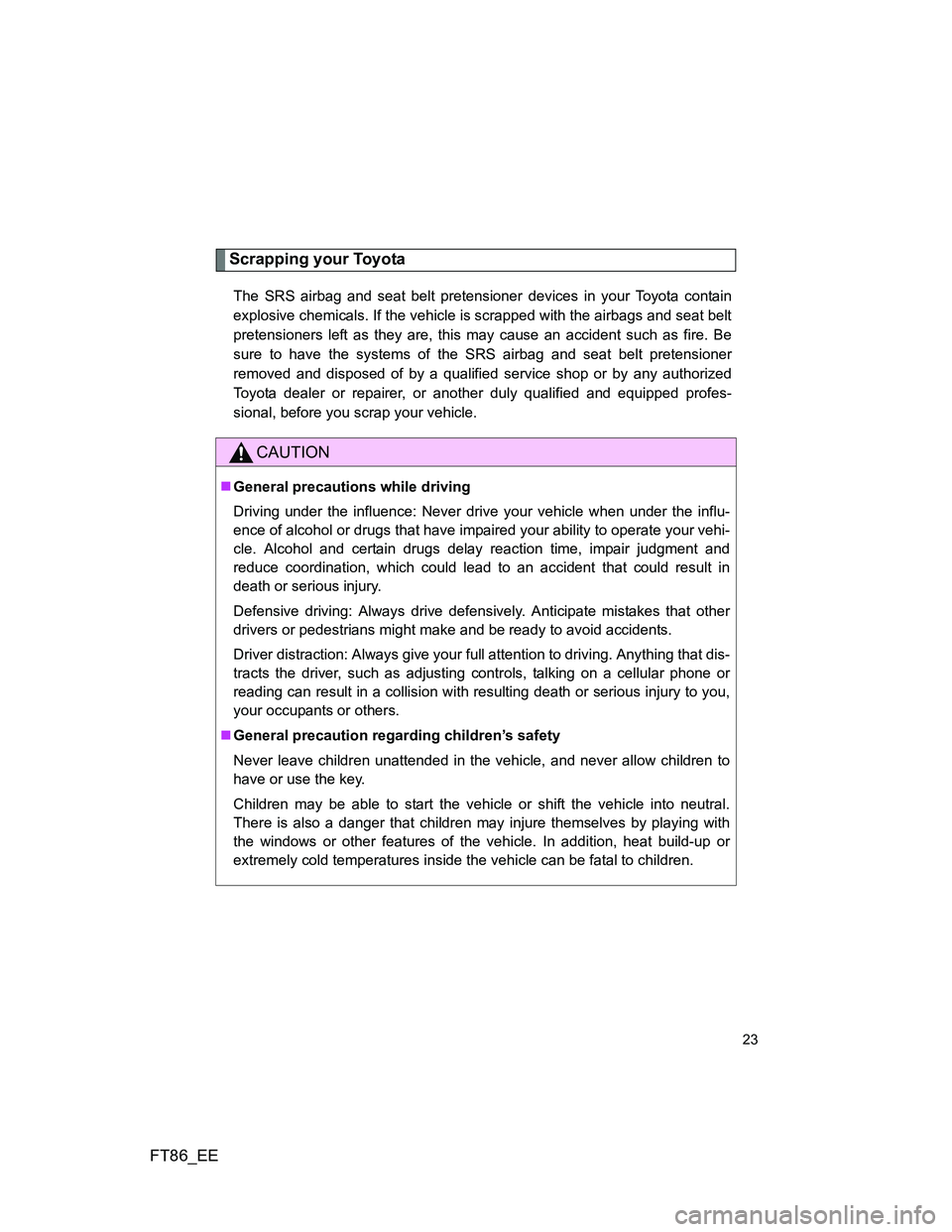
FT86_EE
23
Scrapping your Toyota
The SRS airbag and seat belt pretensioner devices in your Toyota contain
explosive chemicals. If the vehicle is scrapped with the airbags and seat belt
pretensioners left as they are, this may cause an accident such as fire. Be
sure to have the systems of the SRS airbag and seat belt pretensioner
removed and disposed of by a qualified service shop or by any authorized
Toyota dealer or repairer, or another duly qualified and equipped profes-
sional, before you scrap your vehicle.
CAUTION
General precautions while driving
Driving under the influence: Never drive your vehicle when under the influ-
ence of alcohol or drugs that have impaired your ability to operate your vehi-
cle. Alcohol and certain drugs delay reaction time, impair judgment and
reduce coordination, which could lead to an accident that could result in
death or serious injury.
Defensive driving: Always drive defensively. Anticipate mistakes that other
drivers or pedestrians might make and be ready to avoid accidents.
Driver distraction: Always give your full attention to driving. Anything that dis-
tracts the driver, such as adjusting controls, talking on a cellular phone or
reading can result in a collision with resulting death or serious injury to you,
your occupants or others.
General precaution regarding children’s safety
Never leave children unattended in the vehicle, and never allow children to
have or use the key.
Children may be able to start the vehicle or shift the vehicle into neutral.
There is also a danger that children may injure themselves by playing with
the windows or other features of the vehicle. In addition, heat build-up or
extremely cold temperatures inside the vehicle can be fatal to children.
Page 27 of 448
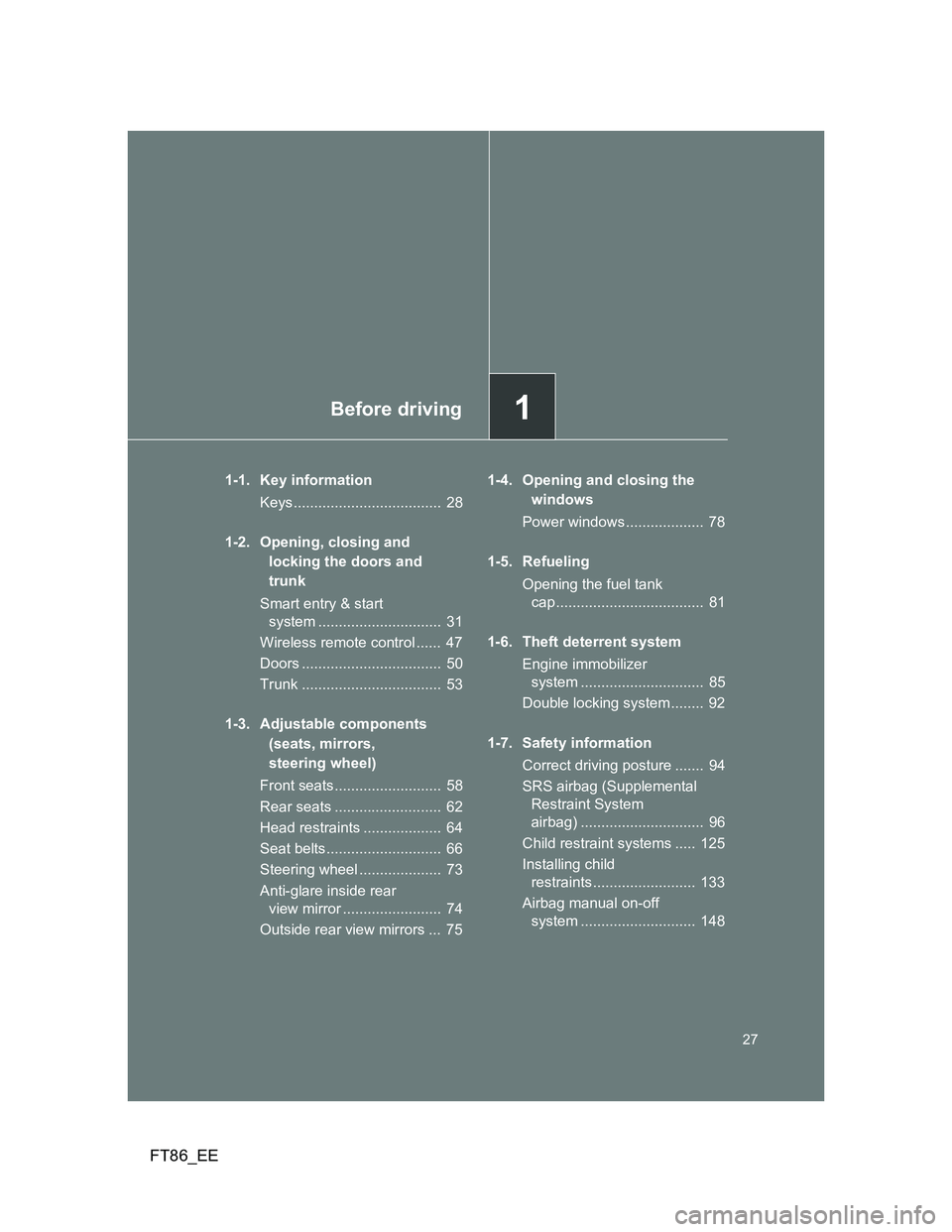
1Before driving
27
FT86_EE
1-1. Key information
Keys.................................... 28
1-2. Opening, closing and
locking the doors and
trunk
Smart entry & start
system .............................. 31
Wireless remote control ...... 47
Doors .................................. 50
Trunk .................................. 53
1-3. Adjustable components
(seats, mirrors,
steering wheel)
Front seats.......................... 58
Rear seats .......................... 62
Head restraints ................... 64
Seat belts............................ 66
Steering wheel .................... 73
Anti-glare inside rear
view mirror ........................ 74
Outside rear view mirrors ... 751-4. Opening and closing the
windows
Power windows ................... 78
1-5. Refueling
Opening the fuel tank
cap .................................... 81
1-6. Theft deterrent system
Engine immobilizer
system .............................. 85
Double locking system ........ 92
1-7. Safety information
Correct driving posture ....... 94
SRS airbag (Supplemental
Restraint System
airbag) .............................. 96
Child restraint systems ..... 125
Installing child
restraints ......................... 133
Airbag manual on-off
system ............................ 148
Page 62 of 448
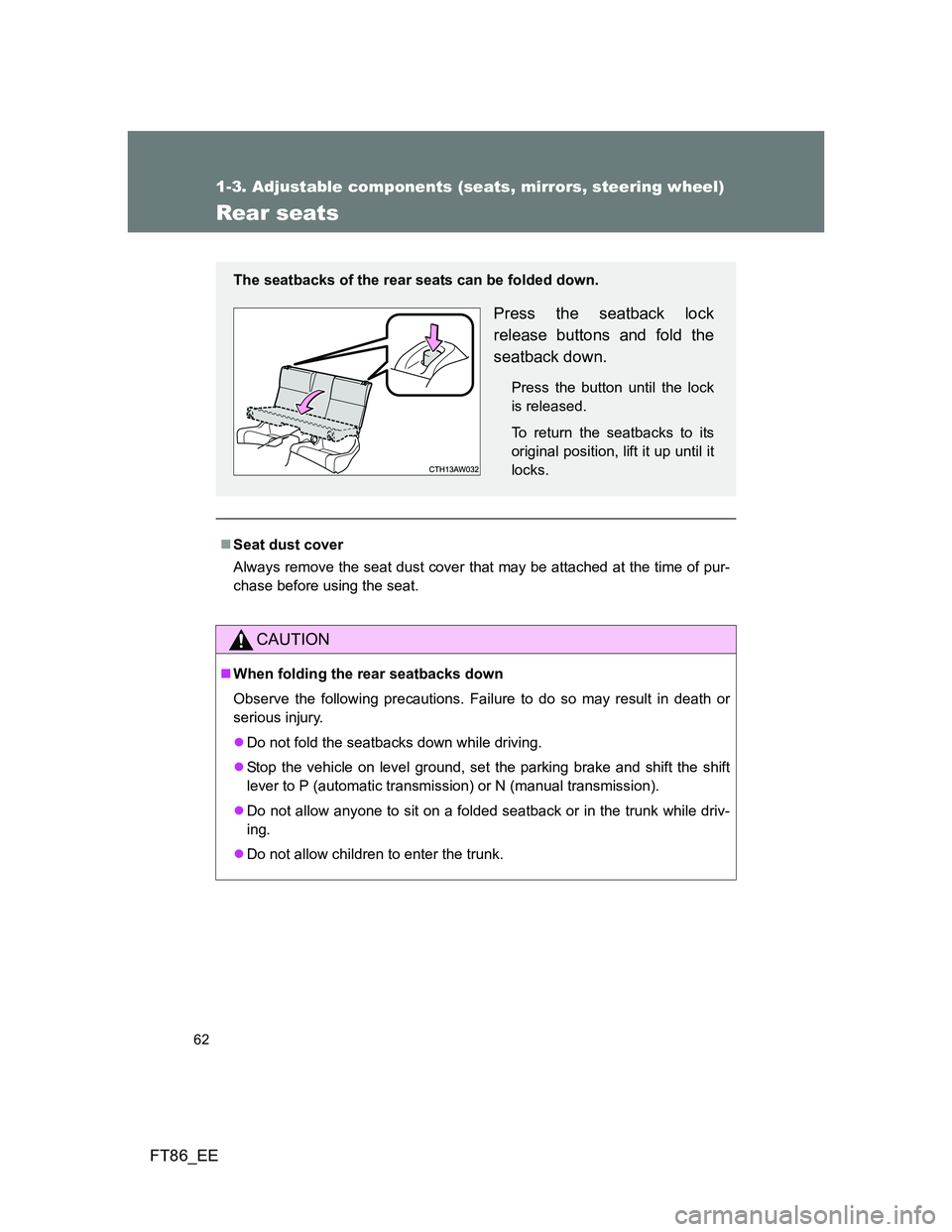
62
1-3. Adjustable components (seats, mirrors, steering wheel)
FT86_EE
Rear seats
Seat dust cover
Always remove the seat dust cover that may be attached at the time of pur-
chase before using the seat.
CAUTION
When folding the rear seatbacks down
Observe the following precautions. Failure to do so may result in death or
serious injury.
Do not fold the seatbacks down while driving.
Stop the vehicle on level ground, set the parking brake and shift the shift
lever to P (automatic transmission) or N (manual transmission).
Do not allow anyone to sit on a folded seatback or in the trunk while driv-
ing.
Do not allow children to enter the trunk.
The seatbacks of the rear seats can be folded down.
Press the seatback lock
release buttons and fold the
seatback down.
Press the button until the lock
is released.
To return the seatbacks to its
original position, lift it up until it
locks.
Page 68 of 448
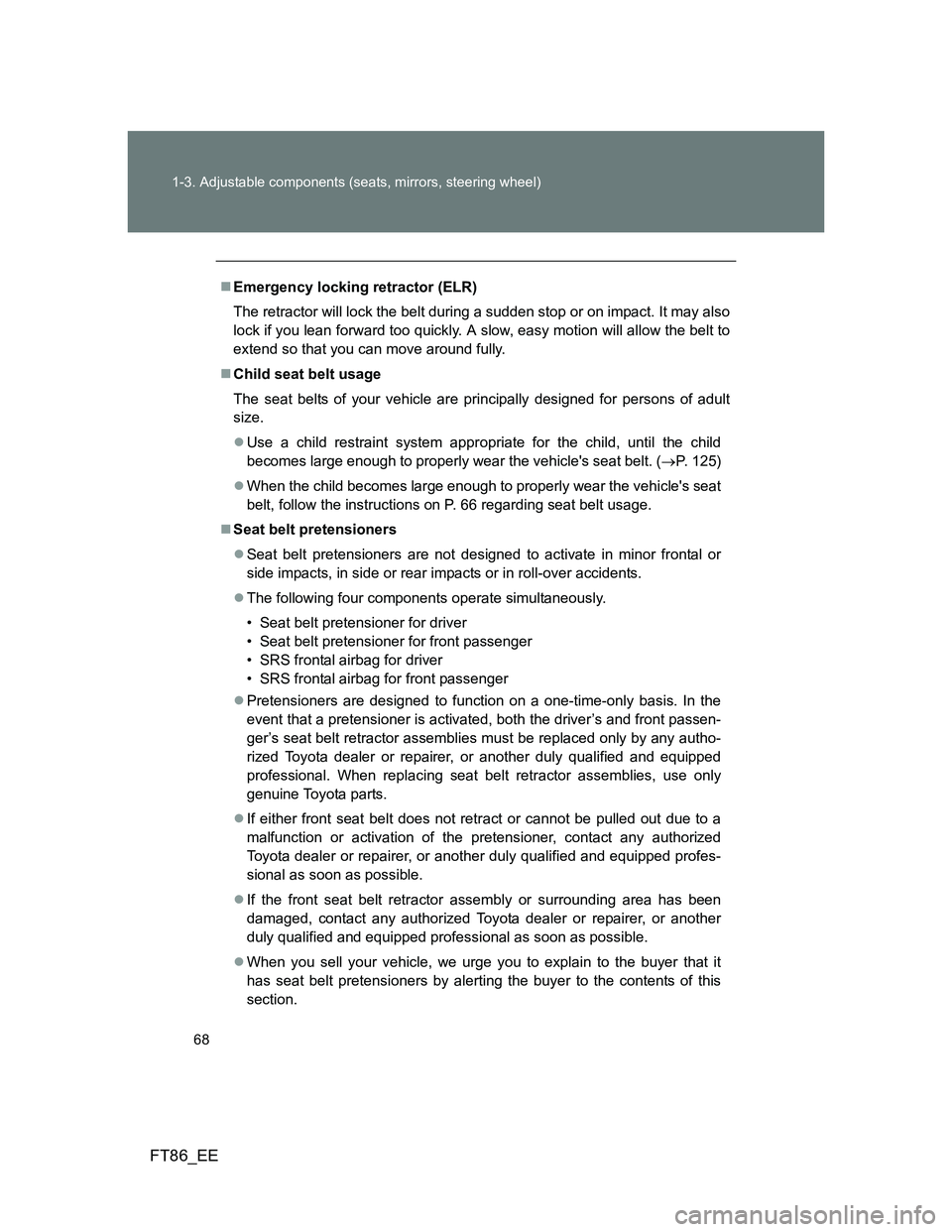
68 1-3. Adjustable components (seats, mirrors, steering wheel)
FT86_EE
Emergency locking retractor (ELR)
The retractor will lock the belt during a sudden stop or on impact. It may also
lock if you lean forward too quickly. A slow, easy motion will allow the belt to
extend so that you can move around fully.
Child seat belt usage
The seat belts of your vehicle are principally designed for persons of adult
size.
Use a child restraint system appropriate for the child, until the child
becomes large enough to properly wear the vehicle's seat belt. (P. 125)
When the child becomes large enough to properly wear the vehicle's seat
belt, follow the instructions on P. 66 regarding seat belt usage.
Seat belt pretensioners
Seat belt pretensioners are not designed to activate in minor frontal or
side impacts, in side or rear impacts or in roll-over accidents.
The following four components operate simultaneously.
• Seat belt pretensioner for driver
• Seat belt pretensioner for front passenger
• SRS frontal airbag for driver
• SRS frontal airbag for front passenger
Pretensioners are designed to function on a one-time-only basis. In the
event that a pretensioner is activated, both the driver’s and front passen-
ger’s seat belt retractor assemblies must be replaced only by any autho-
rized Toyota dealer or repairer, or another duly qualified and equipped
professional. When replacing seat belt retractor assemblies, use only
genuine Toyota parts.
If either front seat belt does not retract or cannot be pulled out due to a
malfunction or activation of the pretensioner, contact any authorized
Toyota dealer or repairer, or another duly qualified and equipped profes-
sional as soon as possible.
If the front seat belt retractor assembly or surrounding area has been
damaged, contact any authorized Toyota dealer or repairer, or another
duly qualified and equipped professional as soon as possible.
When you sell your vehicle, we urge you to explain to the buyer that it
has seat belt pretensioners by alerting the buyer to the contents of this
section.
Page 69 of 448
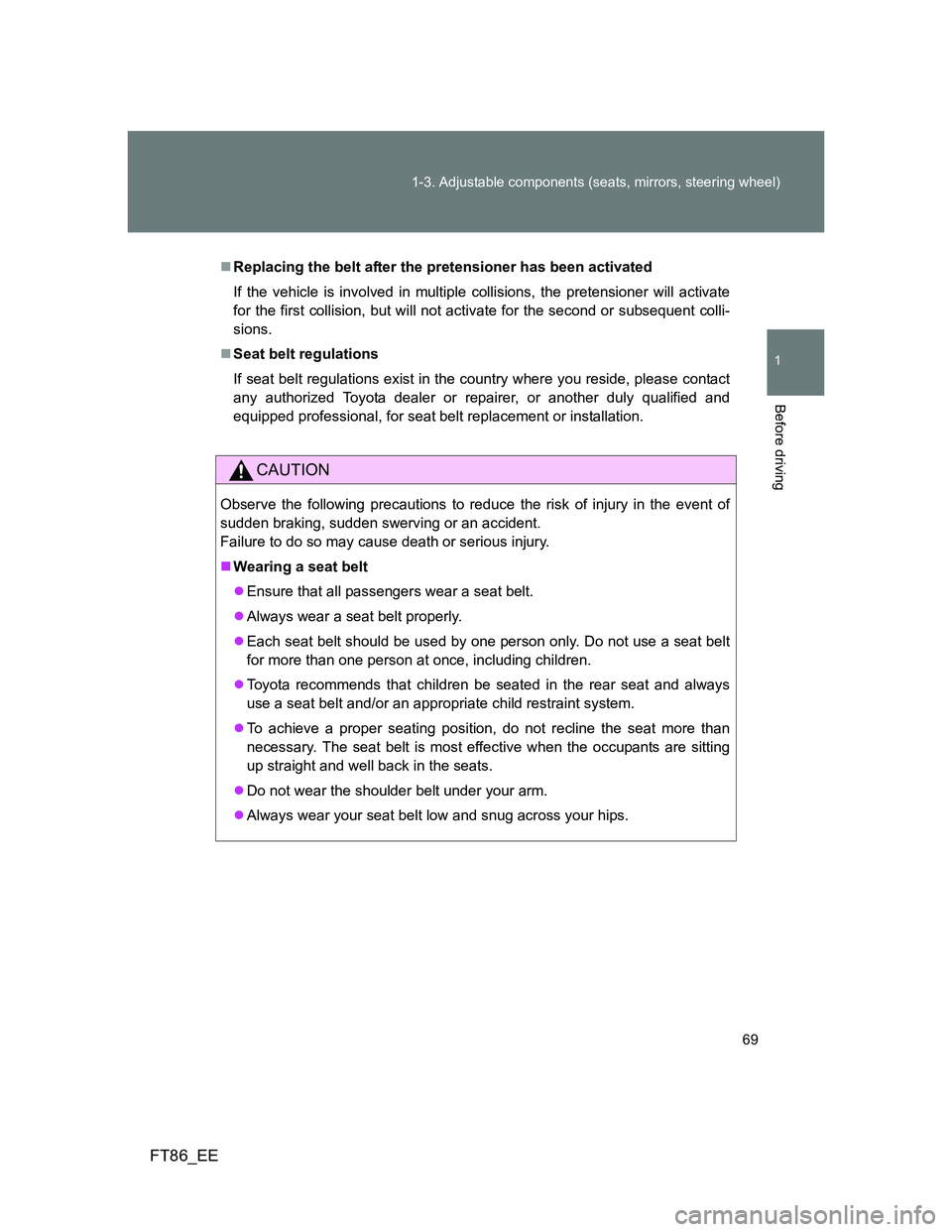
69 1-3. Adjustable components (seats, mirrors, steering wheel)
1
Before driving
FT86_EE
Replacing the belt after the pretensioner has been activated
If the vehicle is involved in multiple collisions, the pretensioner will activate
for the first collision, but will not activate for the second or subsequent colli-
sions.
Seat belt regulations
If seat belt regulations exist in the country where you reside, please contact
any authorized Toyota dealer or repairer, or another duly qualified and
equipped professional, for seat belt replacement or installation.
CAUTION
Observe the following precautions to reduce the risk of injury in the event of
sudden braking, sudden swerving or an accident.
Failure to do so may cause death or serious injury.
Wearing a seat belt
Ensure that all passengers wear a seat belt.
Always wear a seat belt properly.
Each seat belt should be used by one person only. Do not use a seat belt
for more than one person at once, including children.
Toyota recommends that children be seated in the rear seat and always
use a seat belt and/or an appropriate child restraint system.
To achieve a proper seating position, do not recline the seat more than
necessary. The seat belt is most effective when the occupants are sitting
up straight and well back in the seats.
Do not wear the shoulder belt under your arm.
Always wear your seat belt low and snug across your hips.
Page 70 of 448
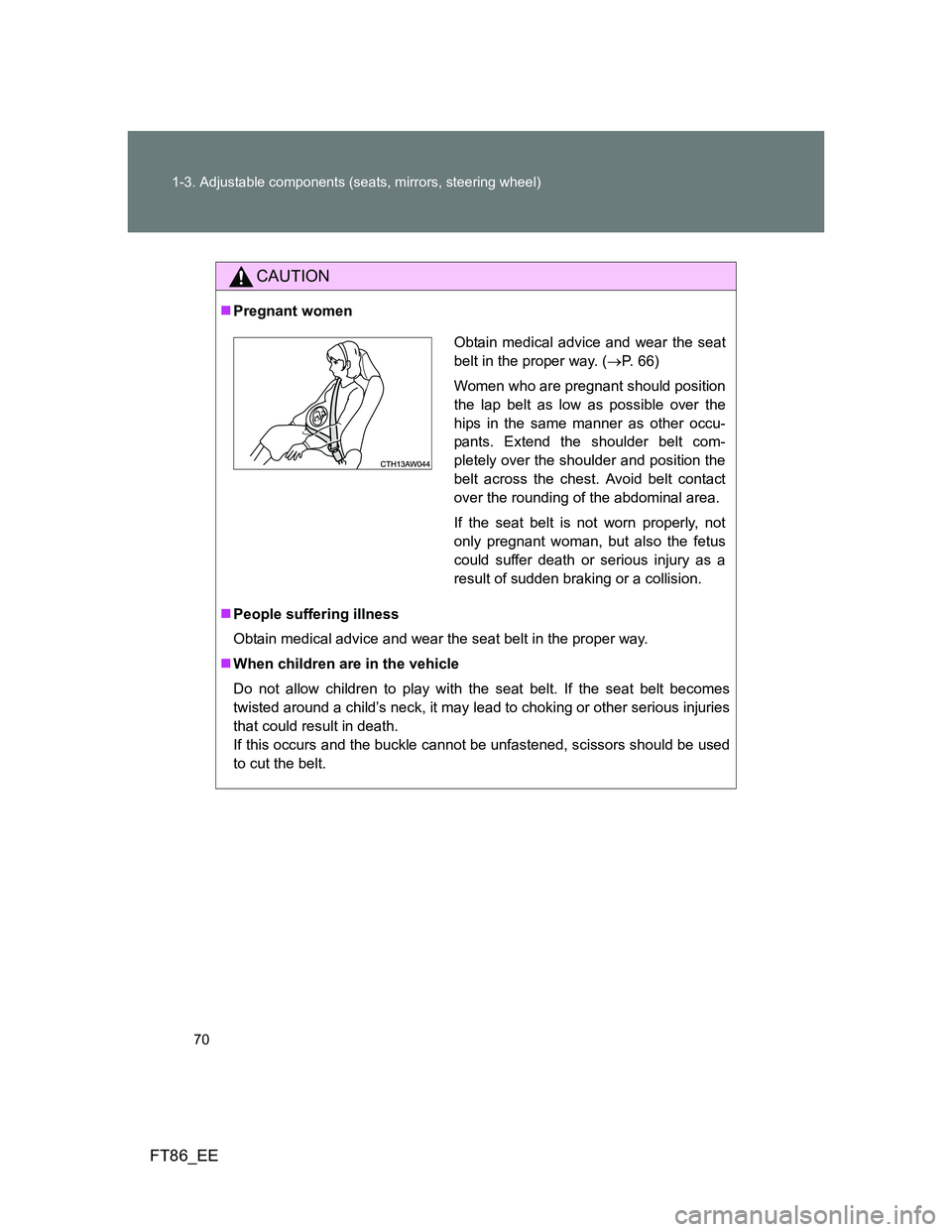
70 1-3. Adjustable components (seats, mirrors, steering wheel)
FT86_EE
CAUTION
Pregnant women
People suffering illness
Obtain medical advice and wear the seat belt in the proper way.
When children are in the vehicle
Do not allow children to play with the seat belt. If the seat belt becomes
twisted around a child’s neck, it may lead to choking or other serious injuries
that could result in death.
If this occurs and the buckle cannot be unfastened, scissors should be used
to cut the belt.
Obtain medical advice and wear the seat
belt in the proper way. (P. 66)
Women who are pregnant should position
the lap belt as low as possible over the
hips in the same manner as other occu-
pants. Extend the shoulder belt com-
pletely over the shoulder and position the
belt across the chest. Avoid belt contact
over the rounding of the abdominal area.
If the seat belt is not worn properly, not
only pregnant woman, but also the fetus
could suffer death or serious injury as a
result of sudden braking or a collision.
Page 99 of 448
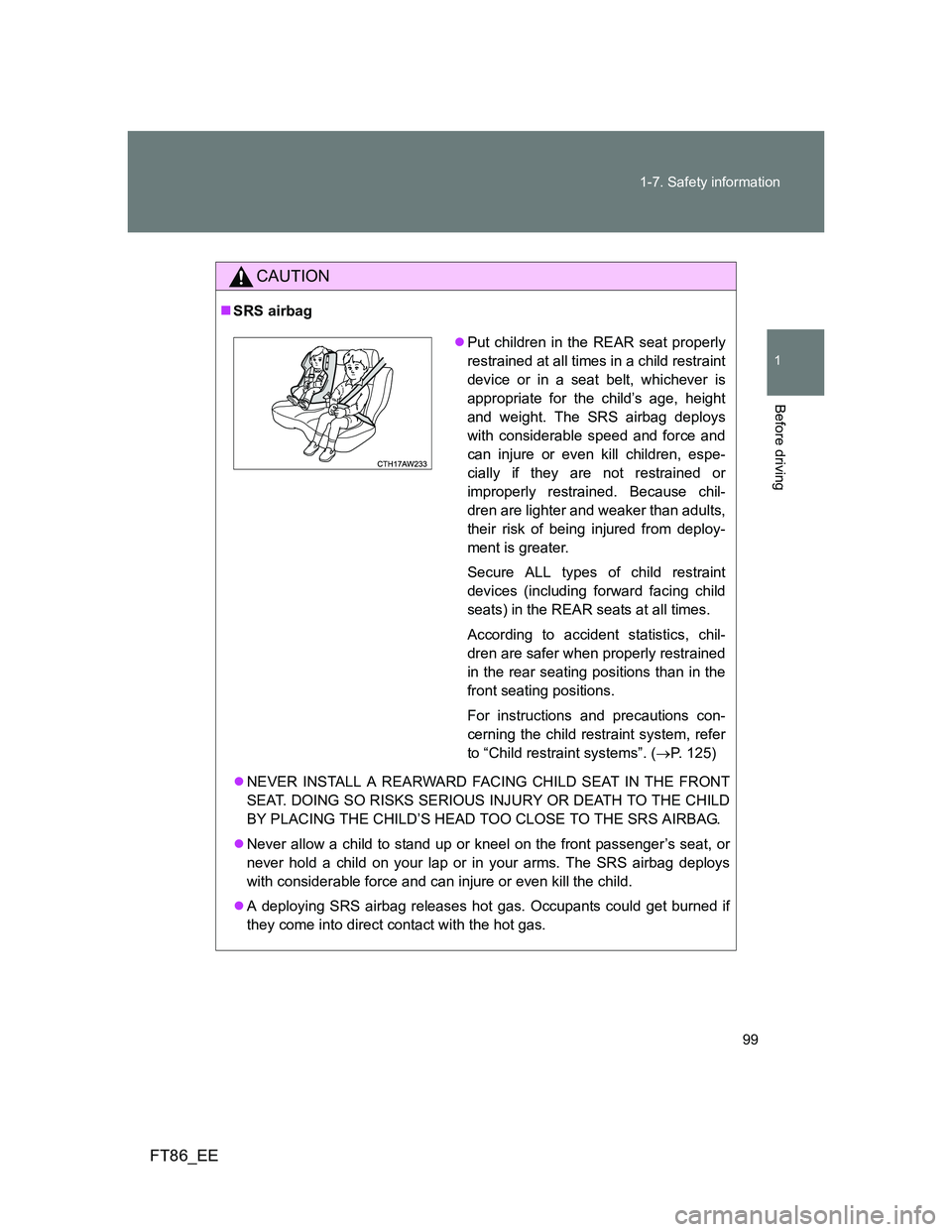
99 1-7. Safety information
1
Before driving
FT86_EE
CAUTION
SRS airbag
NEVER INSTALL A REARWARD FACING CHILD SEAT IN THE FRONT
SEAT. DOING SO RISKS SERIOUS INJURY OR DEATH TO THE CHILD
BY PLACING THE CHILD’S HEAD TOO CLOSE TO THE SRS AIRBAG.
Never allow a child to stand up or kneel on the front passenger’s seat, or
never hold a child on your lap or in your arms. The SRS airbag deploys
with considerable force and can injure or even kill the child.
A deploying SRS airbag releases hot gas. Occupants could get burned if
they come into direct contact with the hot gas.
Put children in the REAR seat properly
restrained at all times in a child restraint
device or in a seat belt, whichever is
appropriate for the child’s age, height
and weight. The SRS airbag deploys
with considerable speed and force and
can injure or even kill children, espe-
cially if they are not restrained or
improperly restrained. Because chil-
dren are lighter and weaker than adults,
their risk of being injured from deploy-
ment is greater.
Secure ALL types of child restraint
devices (including forward facing child
seats) in the REAR seats at all times.
According to accident statistics, chil-
dren are safer when properly restrained
in the rear seating positions than in the
front seating positions.
For instructions and precautions con-
cerning the child restraint system, refer
to “Child restraint systems”. (P. 125)